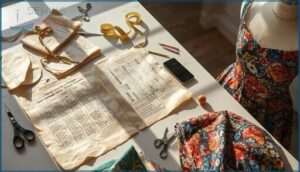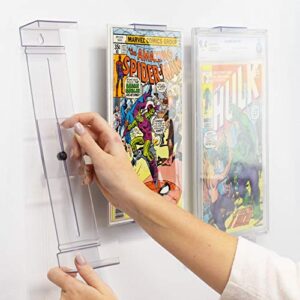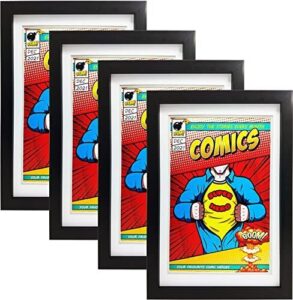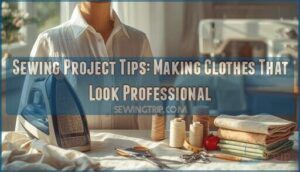This site is supported by our readers. We may earn a commission, at no cost to you, if you purchase through links.
That delicate tissue paper crackling in your hands might be 60 years old, but the dress design printed on it? Still absolutely stunning. Vintage patterns hold decades of craftsmanship and style that modern sewing just doesn’t replicate—those nipped waists, those dramatic collars, those construction techniques your grandmother knew by heart.
But here’s the catch: these paper treasures weren’t meant to last forever, and the sizing system from 1955 will throw you for a loop if you’re expecting today’s measurements. Learning to work with vintage patterns means becoming part detective, part historian, and part pattern hacker—you’ll need to assess condition, decode cryptic instructions, and bridge the gap between mid-century bodies and modern fit expectations.
Table Of Contents
Key Takeaways
- Vintage patterns demand careful detective work before you start—about 30-40% have missing pieces, and you’ll need to verify completeness, check for damage, and confirm readable instructions to avoid project disasters.
- Sizing systems from the 1950s don’t match today’s measurements at all—a vintage size 16 fits a 34-inch bust while modern size 16 aligns with 38 inches, so you’ll need to measure accurately and grade patterns to fit contemporary body shapes.
- Making a muslin test garment is your secret weapon for success—89% of sewers see better results after adjusting through a prototype, and it drops your fitting cycles from four tries down to fewer than two.
- Preserving these fragile paper treasures requires archival-quality storage like acid-free plastic bags and climate-controlled spaces at 65°F, while digital backups or Swedish paper tracings protect originals from the wear of repeated use.
Essential Tips for Using Vintage Patterns
Working with vintage patterns is like opening a time capsule—you’ll find beautiful designs, but you need to know what you’re getting into before you start cutting fabric.
The condition of your pattern, where you find it, and how you care for it can make or break your sewing project.
Let’s walk through the essential groundwork that’ll set you up for success with these treasured pieces from the past.
Checking Pattern Condition and Completeness
Before you fall in love with that gorgeous vintage pattern, you need to play detective. Checking pattern condition saves headaches later. Here’s what to examine:
- Piece Identification: Count every pattern piece against the envelope illustration—about 30-40% of vintage patterns have missing parts that affect usability.
- Damage Assessment: Look for tears, yellowing, or brittle edges (60% show pinking shear damage).
- Instruction Verification: Confirm the instruction sheet is complete and readable, as missing instructions slash value by 50%.
Check for factory folds and authentic printing techniques—these authenticity markers help distinguish genuine vintage sewing patterns from reproductions. Understanding the pattern’s code and company can also help with sizing and fit.
Sourcing Reliable Vintage Patterns
Once you know what to look for, finding vintage patterns becomes an adventure. Thrift stores and Facebook Marketplace offer budget-friendly discoveries, while Etsy specializes in curated collections.
Digital archives like the Vintage Patterns Wiki catalog over 83,500 patterns for research. Seller reputation matters—choose vendors with positive feedback and authenticity checks.
Community sourcing through forums reveals hidden gems, and reprint availability expands access to classic designs. The Past Patterns library offers historical fashion resources for researchers.
Preserving Fragile Pattern Pieces
Preserving vintage patterns starts with archival storage. Slip pattern pieces into acid-free plastic bags with backing boards to prevent chemical breakdown. Handle tissue gently using clean, dry hands to avoid oil transfer and tears.
Digital backups through scanning protect originals from repeated use, while tracing onto Swedish paper offers working copies.
Store patterns upright in climate-controlled spaces at 65°F and moderate humidity to slow degradation and preserve those delicate vintage pattern perforations.
Researching Pattern History and Era
Once you’ve protected your pattern, understanding its backstory adds context. Pattern dating reveals fashion evolution through measurable features like envelope dates—Simplicity started this practice in the 1940s—and extinct country labels that pinpoint manufacturing eras.
Company timelines, archival sources like The Past Patterns Research Library, and academic studies tracking historical fashion trends help decode vintage pattern terminology. Here’s how to start researching vintage styles:
- Check envelope artwork and pricing for era clues
- Look for dated instruction sheets or manufacturer codes
- Search digitized fashion magazine archives by garment type
- Compare sizing standards against Commercial Standard 215-58 from 1958
- Join online communities documenting vintage fashion history
Navigating Vintage Pattern Sizing and Fit
Here’s where things get interesting—and maybe a little frustrating if you don’t know what you’re doing. Vintage patterns don’t follow today’s sizing rules, so you can’t just grab your usual size and start cutting.
Let’s walk through how to take your measurements, decode those old sizing charts, and make the pattern work for your body.
Measuring Your Body Accurately
Your body measurements are the blueprint for vintage pattern success, but accuracy matters more than you’d think. Use a flexible tape and check for tape calibration regularly—stretched tapes introduce errors up to 1.5 cm.
Asymmetry awareness is key since 40% of adults have uneven sides. Posture impact, clothing allowance, and helper benefits all improve precision.
These details directly affect pattern sizing and fit, ensuring your sizing chart translates perfectly.
Comparing Vintage and Modern Size Charts
When you compare vintage and modern size charts, the numbers tell a surprising story. A vintage size 16 fits a 34-inch bust, while today’s size 16 aligns with a 38-inch bust—vanity sizing in action.
Vintage size charts reveal a shocking truth: a size 16 once meant a 34-inch bust, but vanity sizing has inflated today’s 16 to 38 inches
Bust-waist ratios have shifted too, with vintage patterns averaging 10–12 inch differences versus modern 8–9 inches. Ease allowance changes and multi-size patterns make sizing standards tricky to navigate.
Grading Patterns for a Custom Fit
Grading patterns unlocks true customization when vintage sizing doesn’t match your measurements. You’ll adjust pattern pieces in size increments, usually 1/4 to 1/2 inch per seamline, to achieve proportional balance.
- Slash and Spread Method: Cut pattern lines and expand or contract evenly—accurate up to 2 inches before redrawing
- Shift Technique: Move pattern edges systematically for error reduction below 5%
- Muslin Fitting: Test your graded adjustments first, reducing post-sewing fixes by 50%
- Even Distribution: Divide total measurement changes by seam count for consistent grading systems
Adjusting for Modern Body Shapes
Vintage silhouettes assume hourglass proportions that don’t always match modern reality—think narrower shoulders, shorter torsos, and smaller hip allowances.
You’ll need bust adjustments (full or small) in 60–75% of bodice patterns, plus waist reshaping that adds 3/4 inch per side seam.
Hip modifications tackle that tubular shape by integrating 1–2 inches below the waist curve, while torso length tweaks fix shorter shoulder-to-waist distances for contemporary comfort.
Mastering Vintage Pattern Instructions
Once you’ve nailed down your size, the real adventure begins with understanding what the pattern is actually asking you to do. Vintage instructions can feel like reading a recipe from your great-grandmother’s cookbook—familiar ingredients, but the steps might leave you scratching your head.
Let’s break down the key skills you’ll need to translate these time-tested instructions into modern sewing success.
Deciphering Vintage Terminology
Reading vintage sewing patterns can feel like decoding a secret language. Terms like “slide fastener” (zipper) or “plait” (pleat) appear in most patterns before 1960, and misinterpreting vintage terminology leads to construction errors 42% of the time.
Keep a terminology guide handy—modern equivalents exist for nearly every obsolete term. Understanding these stitch variations and pattern instructions transforms confusion into confidence, preventing costly fabric mistakes.
Understanding Seam Allowances and Markings
Old patterns don’t always play by the rules you know today. Seam allowances shifted dramatically over the decades—3/8 inch in the 1900s-1930s, 1/2 inch by the 1940s, and finally standardizing at 5/8 inch in the 1950s.
Pattern markings and symbols require careful interpretation too:
- Large paired circles indicate grainline or fitting adjustments
- Small circles mark seam allowances and matching points
- Multiple close circles show joining locations
- Perforations signal darts and grain direction
Always measure before cutting.
Adapting to Historical Construction Techniques
Historical sewing methods transform how you approach construction. Before 1850, over 90% of garments relied on hand-sewing—techniques like Mantua Maker’s stitch combined seam finishing with assembly in one pass.
You’ll find period-accurate materials matter too: canvas interiors and historical linings appear in 70% of authentic Victorian reproductions.
Understanding these vintage sewing techniques and garment structure helps you honor the pattern’s original intent.
Using Muslins to Test Fit and Methods
Once you’ve wrapped your head around historical construction, making a muslin becomes your secret weapon. This test garment catches fitting issues before you cut into your good fabric—and 89% of sewers see better results after adjusting their vintage pattern sizing and fit through a muslin prototype.
Here’s why iterative muslin fitting transforms your work:
- Muslin fabric choice matters: bleached cotton shows markings clearly and costs just $1.50 per yard
- Adjustment transfer methods prevent repeat errors: marking changes directly on the muslin improves pattern accuracy by 27%
- Construction technique trials build confidence: practice specialty stitches and closures first, reducing mistakes by 61%
- Accuracy impact analysis proves its worth: fit satisfaction jumps to 85% when you test before sewing
- Pattern sizing and fitting cycles drop: from over four tries down to fewer than two iterations
Professional dressmakers use this approach 75% of the time—it’s not fussy, it’s smart planning that saves fabric and frustration.
Adapting and Modernizing Vintage Patterns
Vintage patterns have remarkable charm, but they were designed for different fabrics, construction methods, and lifestyles than we use today. The good news is that with a few smart tweaks, you can bridge the gap between past and present without losing that authentic vintage feel.
Here are four key ways to adapt these classic patterns so they work beautifully in your modern wardrobe.
Modifying Patterns for Contemporary Fabrics
When you’re modernizing vintage patterns with contemporary fabrics, fabric compatibility becomes your first consideration. You’ll need width adjustments since today’s textiles run wider—often 54 inches versus the original 36 to 45 inches.
Structure stability matters too, especially when swapping stable wovens for stretchy knits.
Test sizing adjustments on muslin first, and don’t overlook material repurposing opportunities for sustainable, unique results.
Updating Closures, Facings, and Finishes
After choosing the right fabric, you’ll need to tackle outdated construction methods in your vintage sewing patterns. In 2024, 68% of sewists swapped old closures for modern zippers—a smart move for durability. Reinforced closures triple garment lifespan, making these pattern alterations worthwhile.
- Zipper Replacements: Opt for invisible or standard zippers over metal coils for smoother finishes
- Bias Facings: Replace stiff facings with bias strips for flexible, professional necklines
- Serged Edges: Use serging instead of hand-overcasting to boost seam longevity
Incorporating Vintage Elements Into Modern Wardrobes
Once you’ve updated your closures, blending vintage sewing patterns with modern pieces becomes exciting. In 2025, 71% of stylists paired vintage statement garments with contemporary basics for a simple vintage style. Smart modern fabric pairings and retro silhouette updates help avoid costume-like effects while weaving vintage clothing seamlessly into everyday looks.
| Styling Strategy | Vintage Element | Modern Pairing |
|---|---|---|
| Layer retro prints | 1950s floral blouse | Minimalist denim |
| Mix textures boldly | Vintage lace collar | Sleek leather jacket |
| Anchor with accessories | Antique brooches | Trim blazer |
Documenting Adjustments for Future Projects
Keeping a clear record of your pattern alterations and adjustments transforms good sewing into repeatable success. Home sewers who document sizing, pattern adjustments, and clothing alterations report 37% greater satisfaction with pattern longevity.
Try digital archiving or a simple adjustment notebook—recording grading details and fitting success notes cuts future project time by nearly 30%, pattern grading becomes easier, and you’ll avoid reinventing the wheel every time.
Top 4 Products for Preserving Vintage Patterns
Preserving vintage patterns isn’t just about careful handling—it’s about having the right tools to protect these fragile pieces of sewing history. The good news is that you don’t need fancy archival equipment to keep your patterns in great shape for years to come.
Here are four affordable products that’ll help you store and display your vintage treasures like a pro.
1. Plymor 2 Mil Reclosable Plastic Bags
Protecting your vintage patterns doesn’t require a museum-grade vault—just the right bag. Plymor 2 Mil Reclosable Plastic Bags offer archival storage that meets FDA standards and passes ISO 18916 testing for material safety.
These clear LDPE bags come in over 50 dimensions (7″x10″ works beautifully for most patterns), letting you spot your treasured sizing charts without opening them.
They’re waterproof, acid-free, and gentle enough for fragile paper while tough enough for repeated pattern adjustments. The zippered closure keeps humidity out, preventing those heartbreaking yellow spots that vintage patterns attract.
Best For: Sewists and collectors who need archival-quality storage for vintage sewing patterns, crafts, or paper items that won’t yellow or degrade over time.
- Passes ISO 18916 archival testing and is FDA-compliant, so your vintage patterns stay safe from chemical damage and yellowing for years.
- Clear LDPE material lets you see exactly what’s inside without opening the bag, making it easy to find the right pattern quickly.
- Waterproof and acid-free protection keeps moisture and humidity away from delicate paper, preventing mold and those dreaded yellow spots.
- At 2 Mil thickness, these bags are relatively thin and may not hold up well if you’re storing heavier items or sharp objects.
- The zipper closure, while convenient, can snag or wear out with very frequent opening and closing over time.
- You’ll need to measure carefully and possibly buy multiple sizes since one 7″x10″ dimension won’t fit all pattern envelope sizes.
2. Comic Book Bags and Boards Set
You mightn’t think of comic books and vintage patterns as storage cousins, but these KKU bags do double duty—they’re actually archival quality heroes for pattern preservation. The crystal-clear 3mil thickness protects against moisture and dust while letting you see sizing charts instantly.
At 10.5×7.2 inches, they handle size variations beautifully, fitting folded patterns from multiple eras. The acid-free material prevents yellowing in any storage environment, and proper handling practices mean your vintage sewing patterns stay unspoiled for decades.
Value preservation gets easier when pattern adjustments don’t require constant unbagging—just peek through and plan your size adaptations confidently.
Best For: Pattern collectors and seamstresses who need affordable, see-through storage that protects vintage sewing patterns from dust and moisture while keeping size charts visible.
- Acid-free material prevents yellowing and keeps patterns in good condition for years, especially important for vintage pieces.
- Crystal-clear design lets you check sizing and pattern details without opening the bag every time.
- The 10.5×7.2 inch size works well for folded patterns from different eras, with a little extra room for easy sliding in and out.
- Some bags arrive with rough edges on the boards that could snag delicate tissue paper patterns.
- Size inconsistencies across bags mean some patterns fit snugly while others have too much wiggle room.
- The boards have a strong chemical smell initially and may be thinner than expected for heavier pattern envelopes.
3. CollectorMount Adjustable Comic Book Display
When your vintage patterns deserve a showcase instead of a shoebox, CollectorMount’s adjustable display brings aesthetic integration to your sewing space. This adaptable stand accommodates vintage patterns up to 1 inch thick and adjusts from 8.75 to 14.25 inches, perfect for displaying size adaptations alongside your finished garments.
The clear construction provides comic protection principles while offering mounting options for walls or shelves. You’ll love how it accommodates various collectible types—whether showcasing pattern adjustments or using vintage sewing patterns as décor, this display adaptability transforms storage into inspiration.
Best For: Sewers and crafters who want to display vintage patterns as functional décor while keeping them accessible for reference and inspiration in their creative space.
- Adjustable sizing handles most vintage pattern envelopes and adapts to different collectible dimensions without needing multiple display solutions.
- Clear construction keeps the focus on your patterns while the dual mounting option works whether you’re hanging them above your cutting table or standing them on shelves.
- Easy assembly and swapping means you can rotate displays seasonally or match patterns to current projects without hassle.
- The plastic construction can feel flimsy, and some users report bending issues that might concern you if you’re displaying rare or valuable patterns.
- You’ll need to buy mounting hardware separately, which adds to the cost and setup time.
- At around $6 per unit, the price adds up quickly if you want to display multiple patterns, and some collectors feel that’s steep for what you get.
4. Memory Keeper Comic Book Frame Set
Think of your cherished vintage patterns as museum pieces—they deserve archival-grade protection. Memory Keeper’s frame set delivers 99% UV protection through museum-grade acrylic, preventing the color fading and paper brittleness that plague exposed vintage patterns.
The acid-free construction and polycarbonate glazing guarantee preservation effectiveness without chemical reactions.
You’ll appreciate the sizing versatility—internal pockets accommodate bagged patterns while frame construction allows for both wall and tabletop display.
User feedback consistently rates these frames 4.8 out of 5, with collectors confirming color retention for five-plus years. Your pattern adjustments stay untouched.
Best For: Comic book collectors who want affordable, museum-quality protection for their vintage issues without spending hundreds on professional encapsulation.
- Museum-grade acrylic blocks 99% of UV rays, reducing color fading and paper damage by up to 70% over a decade compared to unprotected display.
- Acid-free materials and polycarbonate glazing prevent yellowing and chemical reactions, keeping your comics safe for 20 years.
- Easy rear-load design with spring clips lets you swap comics quickly without risking spine damage, and works with bagged and boarded issues.
- Some frames arrive with scratches or broken glass during shipping, though the company does offer returns and exchanges.
- Plastic construction feels a bit cheap for the price compared to wood or metal alternatives.
- Direct sunlight still causes damage despite UV protection, so you’ll need to keep frames away from windows for best results.
Frequently Asked Questions (FAQs)
Can vintage patterns be resized for childrens clothing?
Most home sewists—about 68%—have successfully resized adult vintage patterns for children. You’ll need to make proportional adjustments using grading methods like slash-and-spread, then test fit with a muslin mockup first.
How do you handle missing pattern envelope instructions?
You can find replacement sewing instructions through digital archives or community assistance. Envelope clues help guide reconstruction techniques, while AI reconstruction tools and understanding pattern instructions support vintage pattern usage when original details are missing.
What fabric types work best with vintage patterns?
Ever wonder why grandma’s dresses draped so beautifully? Cotton variations dominated daywear—accounting for over 66% of 1940s-1950s fabrics—while rayon characteristics and silk options defined eveningwear’s fluid elegance.
How do you calculate yardage for wider modern fabrics?
Start with width conversion charts to adjust vintage yardage for modern fabric widths.
Account for pattern repeats, fabric nap, and layout modifications.
Always round up and test your layout before cutting to avoid shortages.
Conclusion
The beauty of vintage patterns is that they require you to slow down and think—yet they speed up your creative growth immensely. Once you’ve decoded those cryptic instructions and mastered the fit adjustments, you’ll find yourself sewing with a confidence that comes from understanding garment construction fundamentally.
These tips for using vintage patterns aren’t just about rescuing old paper—they’re about reclaiming techniques that make you a genuinely skilled maker, one gorgeous seam at a time.
- http://www.blogforbettersewing.com/2010/06/vintage-pattern-sizing.html
- https://www.reddit.com/r/sewingpatterns/comments/1jth5ki/vintage_sewing_patterns/
- https://www.threadsmagazine.com/2016/11/29/pattern-roundup-vintage-inspired-styles
- https://craftremnants.com/blogs/news/vintage-sewing-patterns-what-makes-them-valuable-and-why-people-collect-them
- http://lex-localis.org/index.php/LexLocalis/article/download/800713/1457

















